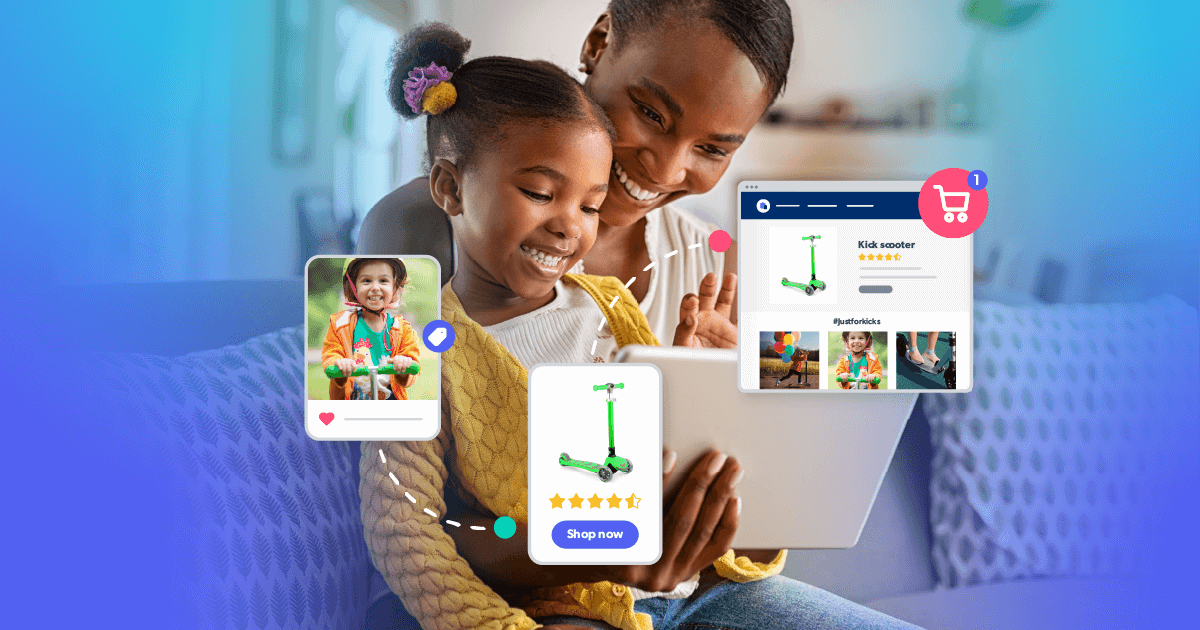March 25, 2024
What were once weekend mall trips are now social media scrolls. With Facebook, Instagram, TikTok, and other social titans rolling out social shopping practices, the thrill of discovery and the joy of buying can happen within a single platform. Anywhere with phone service, at any time.
That’s pretty great for customers. But it’s also a huge opportunity for your brand. The average social media user spends 2 hours and 23 minutes a day on social platforms — that accounts for over a third of every minute spent on the internet. Because you now have the chance to engage with your audience in a more meaningful, direct way, you can turn literally every one of those minutes into a potential moment of conversion.
Chapters:
- Why does social shopping matter for brands
- How brands in different industries win with social shopping
- Access the full benefits of social shopping
Why does social shopping matter for brands
Social shopping addresses a shopper pain point by making it easier for people to connect with what they want to buy. Where social commerce focuses more on selling, social shopping focuses on research and purchases, and improving the whole shopping experience.
Our Shopper Experience Index, an annual report into consumer behavior, tells us that there’s no more debate about the importance of social media and shoppable content. Here’s why:
- Social media is the new search engine. Across the board, 58% of people are discovering products on social platforms. And before hitting the ‘buy’ button, 50% of shoppers are digging deeper, using social media to research their finds
- Young adults are leading the charge. Nearly three quarters (73%) of 18 to 24-year-olds find their next purchase through social media. It’s their mall, their catalog, and their wishlist, all rolled into one
- Buying is the new liking. With 50% of consumers making purchases directly through social media in the past year, the “double tap” has taken on a whole new meaning
- Voice of the customer is key. 78% of consumers feel more confident in a purchase when they view shopper content — that includes creator-, influencer-, and user-generated content
In short, social shopping allows you to meet your customers where they are and where they increasingly prefer to find, research, and buy products.
How brands in different industries win with social shopping
At Bazaarvoice, we have the pleasure of working with brands across every industry under the sun. We’ve helped beauty, CPG, and hardware companies tap into the magic of social shopping and user-generated content (UGC), lift conversion rates, and increase average order value.
We learned a lot from helping our customers. Here, we distill the most important lessons and fascinating case studies to help you.
Health & beauty
The health and beauty industry thrives on visual appeal. Social media platforms are the perfect stage for brands that fall into these categories. They can showcase their products in action, with vibrant images and videos that do more than sell — they tell a story.
UGC plays a starring role here. Rich visual content from customers offers authentic glimpses into real-life results and applications (e.g. is the eyeshadow patchy? Does this foundation look good on a complexion like mine? Is this shampoo the key to becoming the star of the live-action Tangled remake?).
This authenticity is key in an industry where trust and transparency are as important as the products themselves. And if people like what they see, shoppable posts make it easy to click and buy on the spot, turning inspiration into action in mere seconds.
The Body Shop
The Body Shop, a decades-long player in the beauty industry, wanted to enhance its online customer experience. In the words of Indar Chanicka, the brand’s Vice President of E-Commerce, “we set out to fully utilize our social content to drive engagement and use it as a tool to educate customers through their purchasing decisions. We want customers to (…) see the actual products and their benefits through the experiences of real customers.”

To accomplish this goal, The Body Shop integrated social media UGC directly onto product pages. The results? A 28% conversion rate on product pages and a 13% increase in average order value.
Iconic London
Iconic London is a shining example of how brands can bridge the gap between social media inspiration and e-commerce action. First, they recognized the disjointed experience between social platforms and their website. Then, they set out to create a seamless journey that maintained the authenticity and engagement of social media while guiding customers smoothly to the checkout page.

Iconic London implemented Like2Buy, a tool that turns your Instagram pictures and videos into informative, directional, or shoppable posts. This approach allows customers to transition from social media to the website without feeling disconnected.
By coupling UGC, Instagram, and Like2Buy, Iconic London was able to increase conversion rates by 126% and lift average order value by 11% in just 12 months.
Apparel & accessories
Trying on clothes is a pretty important part of the shopping experience. How else will you know if that pair of jeans fits just right? In the context of e-commerce, apparel and accessories brands have found a savvy way to bring the fitting room to their audience, right through their screens.
Social media brings fashion shows to every feed. Each scroll is an opportunity to show off the latest and greatest trends, pieces, and styles in action.
Once again, UGC proves to be a valuable ally. Just like with beauty products, it offers a front-row seat to real-life product demos. Authentic, diverse, and oh-so compelling, this type of content turns everyday customers into the stars of your show, modeling the clothes in their own unique styles and settings.
Isabella Oliver and Baukjen
Isabella Oliver and Baukjen acknowledge the value of showing their clothes on different bodies. The brand embraces visual UGC to enrich the virtual try-on experience and make online shopping feel as personal and engaging as visiting a store.
Their strategy is simple yet impactful: a monthly hashtag contest encourages customers to share their #BaukjenStyle, turning the competition into a curated display of real-world fashion.

Bazaarvoice Galleries then takes these snippets and places them on product pages to create a digital window display that’s both beautiful and relatable. The feedback speaks for itself, with customers expressing newfound confidence in their purchases, inspired by seeing the clothes on bodies just like theirs. This confidence translates into tangible results: a 120% increase in conversion rates and a 10% lift in average order value.
We love Isabella Oliver and Baukjen’s approach because it proves that, in the online fashion world, the best way to know if those jeans fit just right is by seeing them in action.
Home improvement
In the home improvement sphere, the phenomenon of social shopping introduces a dynamic where the aspirational is instantly attainable. Instead of just sources of décor ideas, platforms like Instagram and Pinterest become marketplaces where inspiration seamlessly leads to transactions.
And with a little help from UGC, facilitating this transition becomes easier. Shoppers don’t have to hesitate before buying because they don’t know whether that chaise longue would look good in their homes. You already have a library of relatable content showing them it will.
Dreams
Dreams took their success to new heights with UGC. The brand spotlights their bed frames, sofa beds, and furniture through the lens of real customers’ homes. The #mydreamsbed social media campaign (sensing a #theme here?) showcases customer-inspired bedrooms but also serves as a testament to the power of community in shaping brand perception.

With high-quality, scroll-stopping images populating their homepage, Dreams has created an engaging first impression that draws customers deeper into their product range. Their strategic use of UGC has led to a 200% increase in conversion rate and a 62% rise in average order value.
But perhaps more interesting is how the influx of customer photos has informed Dreams’ own creative direction. Octavia Benham, Dreams’ Head of E-commerce, explains how UGC inspires the team and helps them craft their own content. ”Previously, our own product images didn’t look very lived in, but we changed that based on the UGC content we were getting,” she says.
Consumer electronics
Let’s face it: the more expensive the purchase, the more we rely on other people’s opinions and the longer we consider handing over our money. Such is often the case for consumer electronics, where the price tags tend to be heftier and purchases less frequent.
Given social media’s role as the hottest rising star in consumer research and purchase, there’s an opportunity for brands in this industry to share social proof and nudge people towards purchasing in one fell swoop.
Midland Radio
Midland Radio, a leader in two-way communication devices, recognized the untapped potential of showcasing UGC to enhance their digital presence and boost customer engagement. The brand successfully curated UGC from Instagram, Facebook, and other social channels to enrich their site’s content and make it more relatable.


The results speak volumes: a 143% increase in conversion rate and a 27% increase in average order value. But Midland Radio’s approach didn’t stop with collecting and displaying UGC. With tools like Reveal, Showroom, and Like2Buy, they also enhanced their Instagram strategy, making it easier for followers to transition from browsing to buying.
Food & beverage
Being able to taste a product on social might be a little ways down the road. Thankfully, humans have other senses that food and beverage brands can appeal to. When done right, visuals can almost convey flavors, aromas, and textures (drink if you’ve never “eaten” with your eyes!)
Social media is the perfect place for storytelling. Food and beverage brands can get creative with their shoppable posts by sharing recipes that feature their products or partnering with food influencers and UGC creators who show the goods in action (yes, this does include eating said goods. There’s a reason mukbangs are still a popular type of content — some people just enjoy seeing other people eat. It is what it is).
T2 Tea
T2 chose to stir up their social shopping strategy with UGC and shoppable posts. They partnered with Bazaarvoice to amplify brand presence and cultivate a digital environment that mirrors the communal and sensory nature of enjoying a steaming cup of tea.

“Our aim is to create a community of tea lovers,” said Sally Lennox, Head of Digital at T2. “UGC is a way for us to embrace our customers by hearing their unique perspectives and displaying that word-of-mouth content on our digital screens. It provides such powerful social proof when customers can see that others are loving our products.”
T2 celebrates its fans by capturing and posting social media UGC on its home and product pages with Bazaarvoice Galleries. The brand also implemented Like2Buy and shoppable posts on Instagram so browsers can immediately access the products that catch their eye.
Consumer packaged goods
The landscape of consumer packaged goods (CPG) is a competitive one, with direct-to-consumer (DTC) companies increasingly taking over a share of the market. Building trust and signaling safety is thus becoming more and more essential.
Many CPG brands are turning to social media to push educational content highlighting how real people use their products to make their lives better/easier/more fabulous. And if there’s a direct path to purchase right there in the posts? That’s the cherry on top.
MAM
Understanding the concerns and desires of parents who want the best for their little ones, MAM UK harnessed the power of social proof. So the brand leveraged real-life experiences and endorsements from satisfied parents to reassure potential customers.
To amplify their UGC strategy, MAM implemented social commerce solutions, effectively completing their full-funnel marketing approach. Bazaarvoice Galleries allowed MAM to curate and display authentic social photos and videos from advocates, creating beautiful product galleries on their website.

The strategy made their products more relatable, which translated into engagement and profit — more precisely, a 258% increase in time on site, a 108% increase in conversions, and a 58% increase in average order value.
Access the full benefits of social shopping
Social shopping isn’t a fad — it’s the new normal. And if you have the right tools and the right partners, there’s no reason why you won’t be able to adapt and thrive.
Dive into the world of social shopping with the ultimate guide to social media conversion for more actionable tips on how to create captivating shopping experiences that impact your bottom line.










